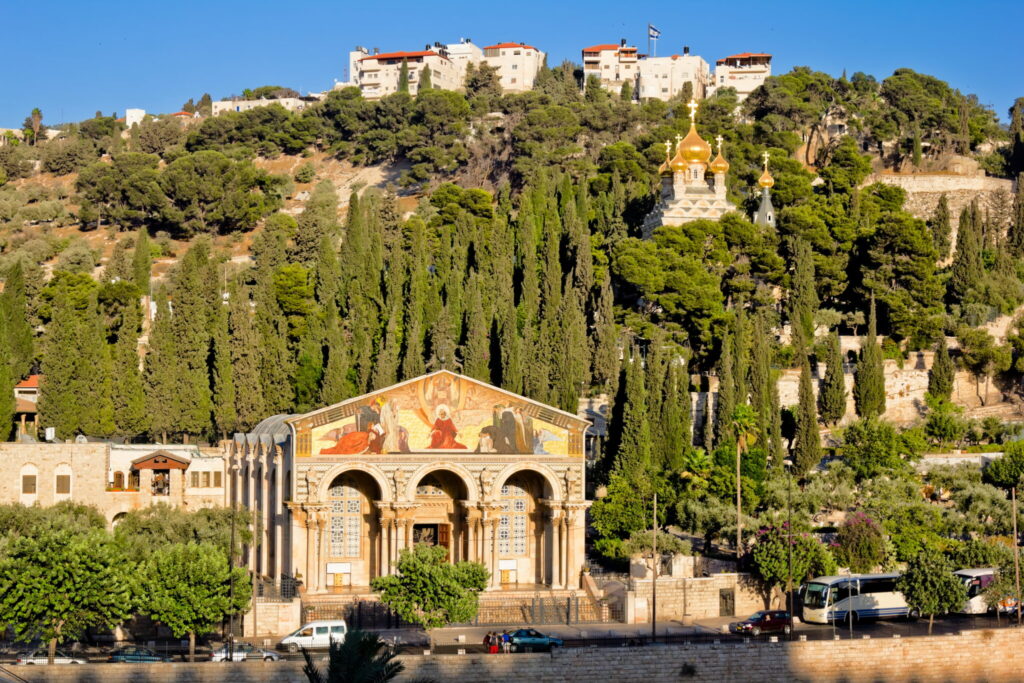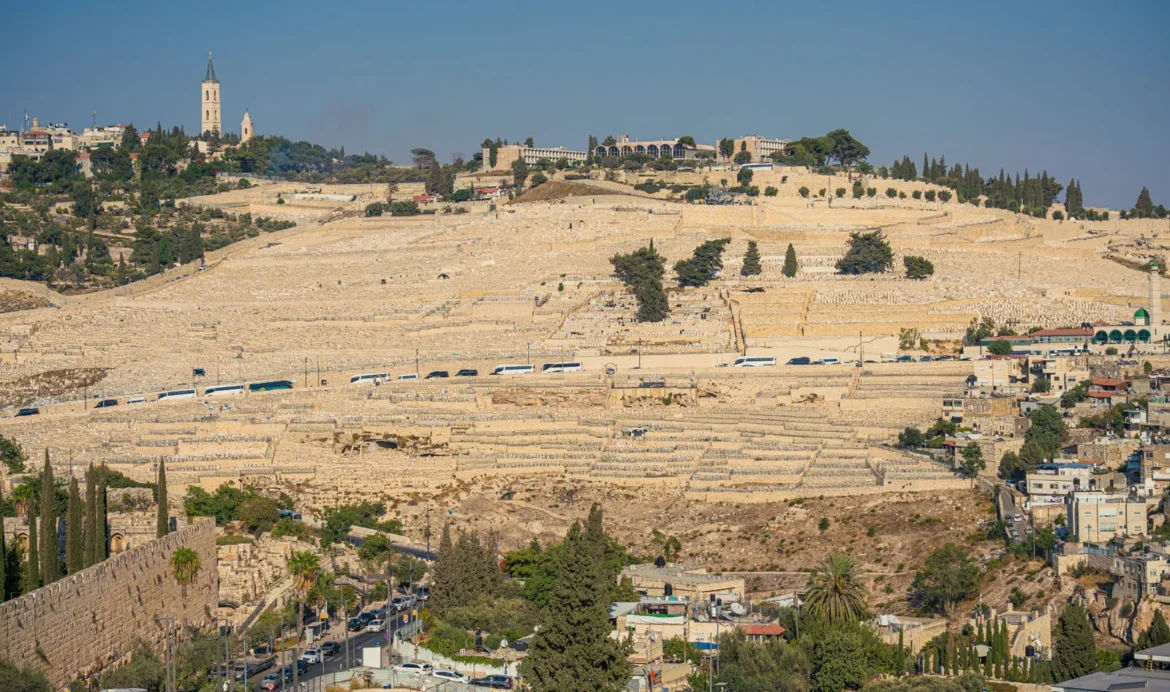When you gaze across Jerusalem’s eastern horizon, you cannot miss the long ridge of hills rising beyond the Old City—the Mount of Olives. For millennia, this storied ridge has stood as a silent witness to the unfolding drama of faith, history, and prophecy. Revered in Judaism, Christianity, and Islam, the Mount of Olives is not just a geographical landmark but a living spiritual landscape, rich with sacred sites, breathtaking views, and profound meaning.

The Geography of the Mount
The Mount of Olives is a limestone ridge that rises to about 826 meters (2,710 feet) above sea level, running north to south along Jerusalem’s eastern edge. It overlooks the Kidron Valley and directly faces the Old City and the Temple Mount/Haram al-Sharif. Its name comes from the olive groves that once blanketed its slopes and are still present in patches today.
The ridge is divided into three main summits:
- Mount Scopus (north), home today to the Hebrew University and the Hadassah Medical Center.
- The central Mount of Olives, where many of the holy sites are concentrated.
- The Mount of Offense (south), traditionally associated with King Solomon’s idolatrous shrines (1 Kings 11:7).
This geography has made the Mount of Olives both a vantage point and a sacred landscape for thousands of years.
Jewish Significance: The Mountain of Resurrection
For Jews, the Mount of Olives is one of the most sacred places outside the Temple Mount. It has been used as a Jewish cemetery for over 3,000 years, making it the oldest continually used cemetery in the world. Tradition holds that when the Messiah comes, the resurrection of the dead will begin here, with the righteous rising first.
Burial on the Mount is therefore considered highly desirable, and today more than 150,000 graves cover its slopes. Among them are tombs of revered rabbis, leaders, and scholars, as well as biblical figures traditionally associated with the site, such as the prophets Haggai, Zechariah, and Malachi.
The Tomb of Zechariah, a striking rock-cut monument from the Second Temple period, remains one of the most iconic landmarks at the foot of the Mount, near the Kidron Valley.
Christian Significance: The Mountain of the Passion
For Christians, the Mount of Olives holds profound importance as the setting of key events in the life of Jesus Christ, particularly during the last week of his life.
- Palm Sunday: According to the Gospels, Jesus entered Jerusalem riding a donkey, descending from the Mount of Olives as crowds spread palm branches before him (Matthew 21:1–11).
- Gethsemane: At the foot of the Mount lies the Garden of Gethsemane, where Jesus prayed in anguish on the night of his arrest. The Church of All Nations (also known as the Basilica of the Agony) now marks this sacred site.
- The Ascension: Christian tradition holds that Jesus ascended to heaven from the summit of the Mount of Olives (Acts 1:9–12). Several churches and chapels commemorate this event, including the Chapel of the Ascension, which still contains a stone believed to bear the imprint of Jesus’ footprint.
The Mount of Olives thus becomes the mountain of Jesus’ passion, prayer, and triumph—an essential stop for pilgrims retracing his steps.
Islamic Significance: A Mountain of Judgment
In Islam, the Mount of Olives also carries eschatological meaning. Many traditions hold that it will be the place of resurrection and final judgment at the end of days. The ridge is associated with the events of the Isra and Mi’raj, the Prophet Muhammad’s night journey and ascension, and with future prophecies about the Day of Judgment.
Muslim reverence for the Mount is further reflected in the presence of Islamic shrines and historical structures on its slopes, including mosques and burial sites connected to Islamic tradition.
Sacred Sites on the Mount of Olives
Walking along the Mount of Olives is like moving through a living tapestry of sacred history. Among the most significant sites are:
1. The Jewish Cemetery
Stretching across the western slopes, this vast cemetery holds graves dating back to biblical times. Famous figures buried here include Eliezer ben Yehuda (reviver of the Hebrew language) and Menachem Begin (former Israeli Prime Minister).
2. The Garden of Gethsemane and Church of All Nations
At the foot of the Mount, near the Kidron Valley, lies the Garden of Gethsemane. Ancient olive trees, some believed to be thousands of years old, still grow here. The adjoining Church of All Nations, with its beautiful mosaics, marks the site where Jesus prayed on the night of his arrest.
3. Dominus Flevit (“The Lord Wept”)
Halfway down the slope is the tear-shaped Dominus Flevit Church, built by Italian architect Antonio Barluzzi in the 1950s. It commemorates the moment when Jesus wept over Jerusalem (Luke 19:41–44). Its windows frame a stunning view of the Old City and the golden Dome of the Rock.
4. The Chapel of the Ascension
At the summit stands the modest Chapel of the Ascension, a small octagonal structure that marks the traditional site where Jesus ascended to heaven. The stone floor contains a revered imprint said to be from his right foot. Interestingly, this shrine is now under Muslim custodianship, but it is open to pilgrims of all faiths.
5. The Pater Noster Church
Nearby is the Church of the Pater Noster, built over a cave associated with Jesus teaching his disciples the Lord’s Prayer. Its walls are adorned with the prayer in over 140 languages.
6. Tombs in the Kidron Valley
At the base of the Mount are monumental rock-cut tombs, including the Tomb of Zechariah, the Tomb of Absalom, and the Tomb of the Sons of Hezir. These striking monuments stand as timeless witnesses to Jerusalem’s ancient history.
A Panoramic View of Jerusalem
One of the greatest highlights of the Mount of Olives is the view. From its ridge, you can see the Old City of Jerusalem in its entirety—the golden Dome of the Rock, the gray domes of the Church of the Holy Sepulchre, and the sprawling walls that enclose centuries of sacred history.
Pilgrims often pause here for reflection, photographs, or simply to take in the breathtaking panorama. For many, it is one of the most unforgettable vistas in the world—a view that bridges heaven and earth.
A Place of Prophecy and Hope
The Mount of Olives is not only a place of memory but also of prophecy. Both Jewish and Christian traditions associate it with the coming of the Messiah and the end of days. The prophet Zechariah envisioned that on the day of the Lord, the Mount of Olives would be split in two, creating a great valley (Zechariah 14:4).
For Jews, this makes the cemetery especially significant, as those buried here will be the first to rise in the resurrection. For Christians, the Mount embodies both the sorrow of Jesus’ passion and the hope of his return. For Muslims, it is tied to the Day of Judgment and the final gathering of humanity.
Modern Life on the Mount
While steeped in history, the Mount of Olives is also home to vibrant modern communities. The area includes Palestinian neighborhoods, monasteries, convents, and churches belonging to various Christian denominations. Despite political tensions that sometimes affect access, the Mount continues to welcome pilgrims and visitors from around the world.
Efforts to preserve the historic cemetery and holy sites are ongoing, balancing modern realities with the Mount’s sacred legacy. Walking through its winding paths, one senses both the challenges and the enduring resilience of this holy ridge.
Visiting the Mount of Olives
For travelers, a visit to the Mount of Olives is both a spiritual and scenic experience. The best way to explore is on foot, starting from the summit and walking down toward the Old City. This route retraces many of the biblical and historical events associated with the Mount.
Practical tips:
- Best time to visit: Early morning or late afternoon, when the light enhances the views of Jerusalem.
- Dress modestly: As with all sacred sites in Jerusalem, respectful attire is recommended.
- Plan time for reflection: Beyond sightseeing, the Mount invites moments of prayer, meditation, or quiet appreciation.
Why the Mount of Olives Matters
The Mount of Olives matters because it embodies the deep intertwining of geography and faith. It is not simply a ridge of hills—it is a sacred stage where prophets, kings, and messiahs have walked; where prayers of hope, sorrow, and longing have been offered for thousands of years.
For Jews, it is the mountain of resurrection. For Christians, the mountain of passion and ascension. For Muslims, a mountain of judgment and prophecy. For all, it is a mountain of memory and vision, rising above Jerusalem as a testament to humanity’s search for the divine.
Conclusion
The Mount of Olives is more than a landmark—it is a living story of faith, history, and hope. Its olive trees whisper the prayers of generations; its stones bear witness to triumph and tragedy; its slopes carry the footsteps of prophets and pilgrims alike.
To stand on the Mount of Olives is to see Jerusalem not just with the eyes, but with the heart. It is to feel the weight of history and the light of faith converge in one sacred place. And whether you arrive as a pilgrim, a traveler, or a curious visitor, the Mount of Olives will leave an imprint on your soul—an enduring reminder of the holy city it overlooks and the eternal hope it represents.

